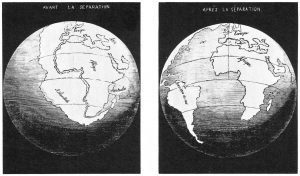Chapter 4. Plate Tectonics

Chapter Goals
Complete this chapter so you can:
- Discuss the early evidence for continental drift, and Alfred Wegener’s role in promoting this theory.
- Describe other models that were used early in the 20th century to understand global geological features.
- Summarize the geological advances that provided the basis for understanding the mechanisms of plate tectonics, and the evidence that plates and are constantly being created and destroyed.
- Describe the seven major plates, including their size, motion, and the types of boundaries between them.
- Describe the geological processes that take place at divergent and convergent plate boundaries, and explain why transform faults exist
- Explain how supercontinents form and how they break apart.
- Explain why tectonic plates move.
Introduction
Plate tectonics is the model or theory that we use to understand how our planet works: it explains the origins of continents and oceans, the origins of folded rocks and mountain ranges, the presence of different kinds of rocks, the causes and locations of earthquakes and volcanoes, and changes in the positions of continents over time. So… everything!
The notion of continental drift—that the continents have moved over time—is both new and old. It’s old in the sense that people have long speculated it might be the case. For example, in 1858 Antonio Snider-Pellegrini published a reconstruction of a single ancient continent working from observations of how modern continents appear to fit together like puzzle pieces (Figure 4.2). Continental drift is new in the sense that the idea was vigorously resisted by practicing geologists until as late as the 1960s.

Versions of what we now know as the theory of plate tectonics have circulated in the geologic community for more than 150 years, and the question of moving continents was tackled in earnest by Alfred Wegener starting at the beginning of the 20th century. So it may come as a surprise that such a key idea underpinning the study of Earth today did not become an accepted part of geology until the 1960s.
A Very Touchy Subject
As late as 1962, Keith Runcorn prefaced with exceeding delicacy an edited volume entitled Continental Drift, in what looks like an attempt to convince skeptical readers that a book called Continental Drift was merely continental drift-ish, generally speaking, and certainly not pro continental drift.
On the one hand, he rationalized, “the development of studies of rock magnetism…has caused geophysicists in other fields to reconsider the ideas in relation to their own studies,” so maybe it wasn’t such a bad idea to put together a book on what was known about “horizontal movements in the earth’s crust in its widest sense.” (But certainly not in the narrow “continental drift” sense). He followed that up by affirming, “This is not the time for a reappraisal of Wegener’s work,” and then de-affirmed, “a subject formerly considered by many earth scientists as already closed.” (p. vii, emphasis added.)
It took a long time for Wegener’s continental drift theory to become accepted for two main reasons. First, it was a radically different perspective on how Earth worked, and geologists were reluctant to entertain an idea that seemed preposterous in the context of the science of the day. The evidence and understanding of Earth that would have supported plate tectonic theory simply didn’t exist until the mid-twentieth century.
Consider that in the same book, Bruce Heezen—whose colleague Marie Tharp had by that time produced detailed maps of mid-ocean ridge rift valleys, and interpreted them in the context of continental drift—focused on a description of continental drift that made it sound utterly improbable:
According to the hypotheses of continental drift there have always been continents and oceans, but patterns of distribution have varied through time. Such changes have been accomplished by the drift of continents through oceans much in the way icebergs drift through seawater. The block composing the sea floor is assumed to be relatively weak with respect to the more rigid blocks constituting the continents. (p. 276)
A second reason is that the opinion of many Earth scientists was affected by their view of Alfred Wegener himself. Wegener was not trained as a geologist, so he lacked credibility in the eyes of the geological community. Alfred Wegener was also German, whereas the geological establishment was centred in Britain and the United States—and Britain and the United States were at war with Germany in the first part of the 20th century.
In summary, plate tectonics was an idea too far ahead of its time, and delivered by the wrong messenger.
References
Runcorn, S. K. (Ed.). (1962). Continental Drift. Academic Press.
Thordarson, T., and Larsen, G. (2007) Volcanism in Iceland in historical time: Volcano types, eruption styles and eruptive history. Journal of Geodynamics 43, 118–152. Full text

